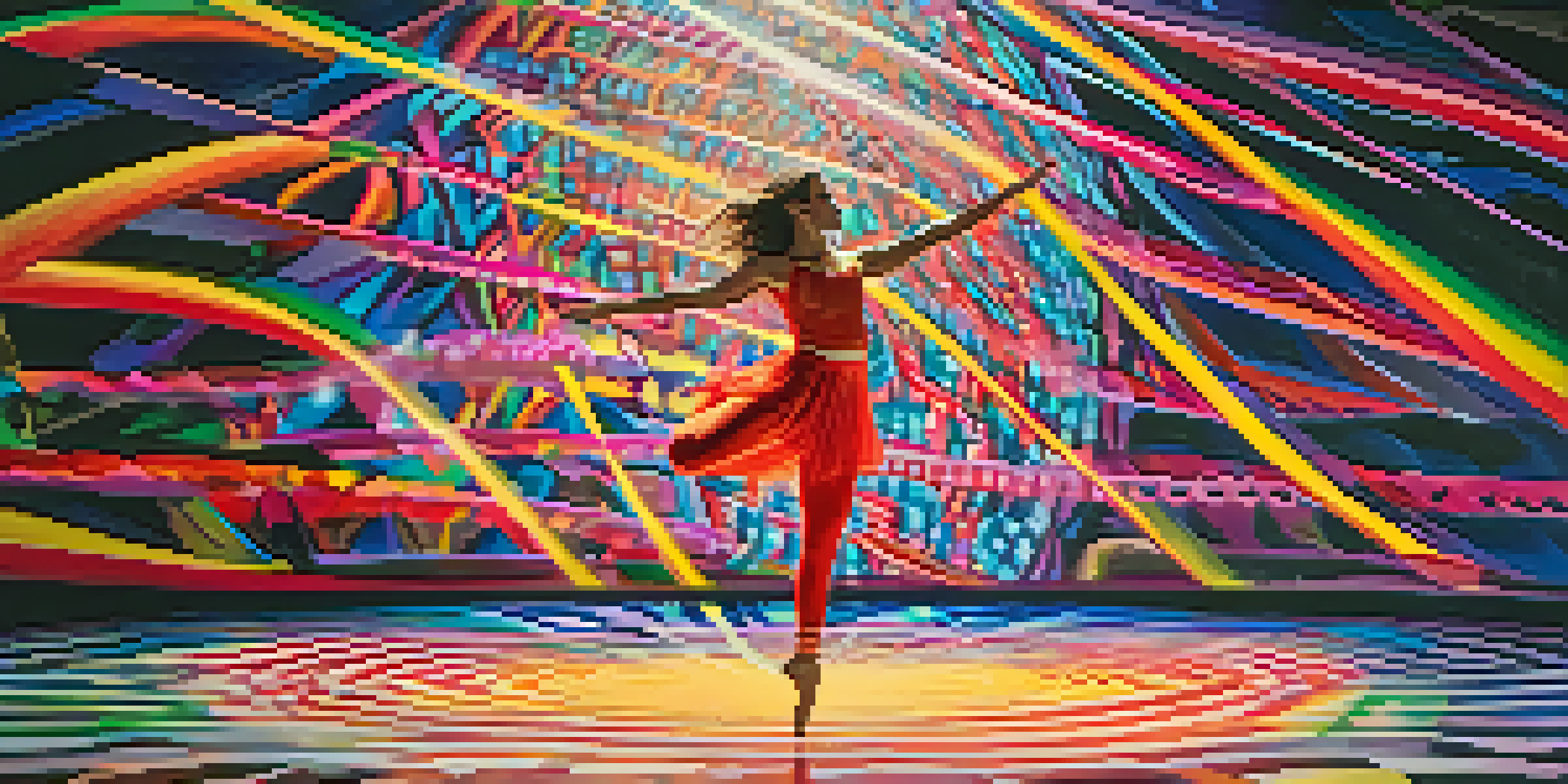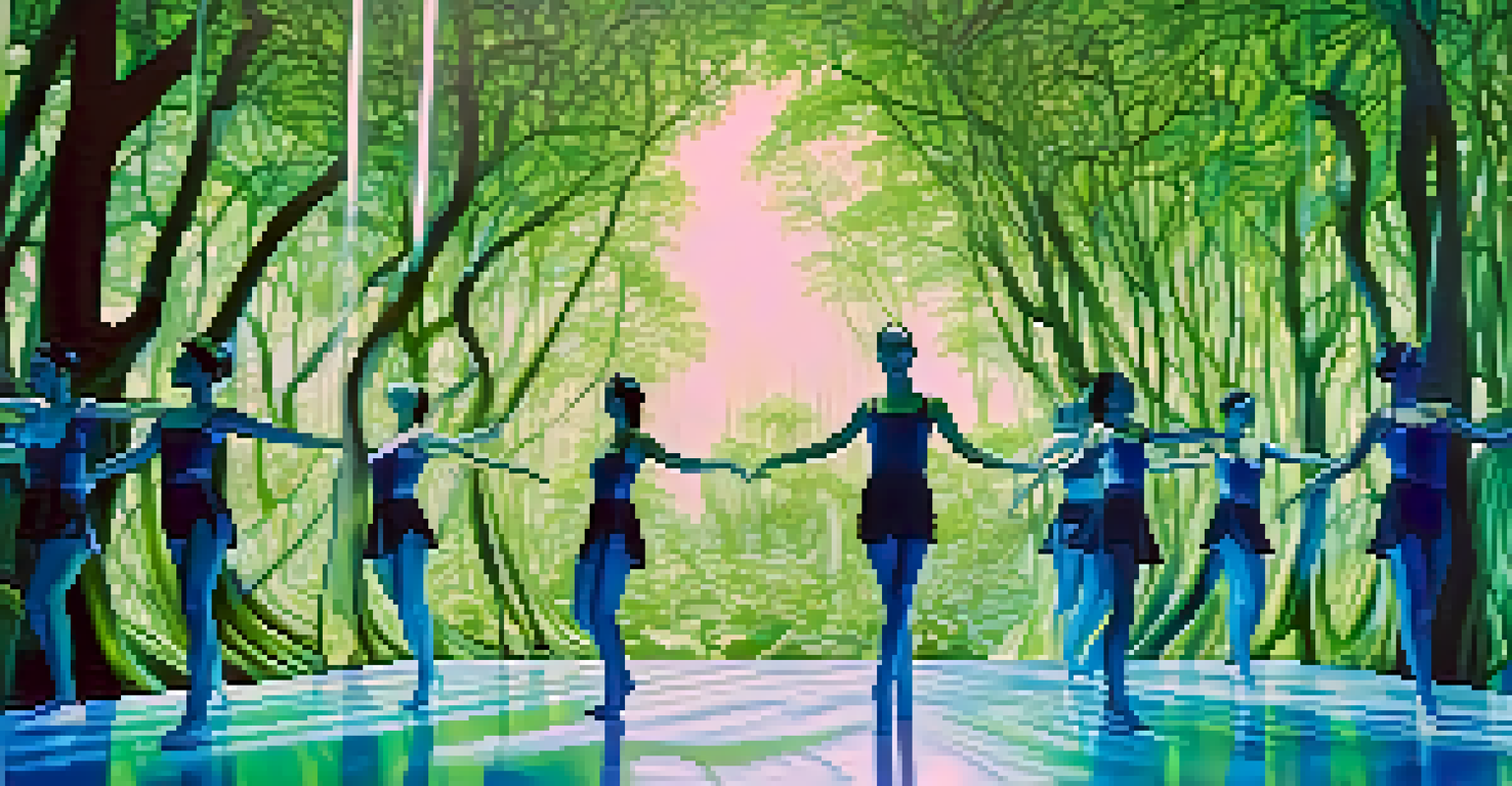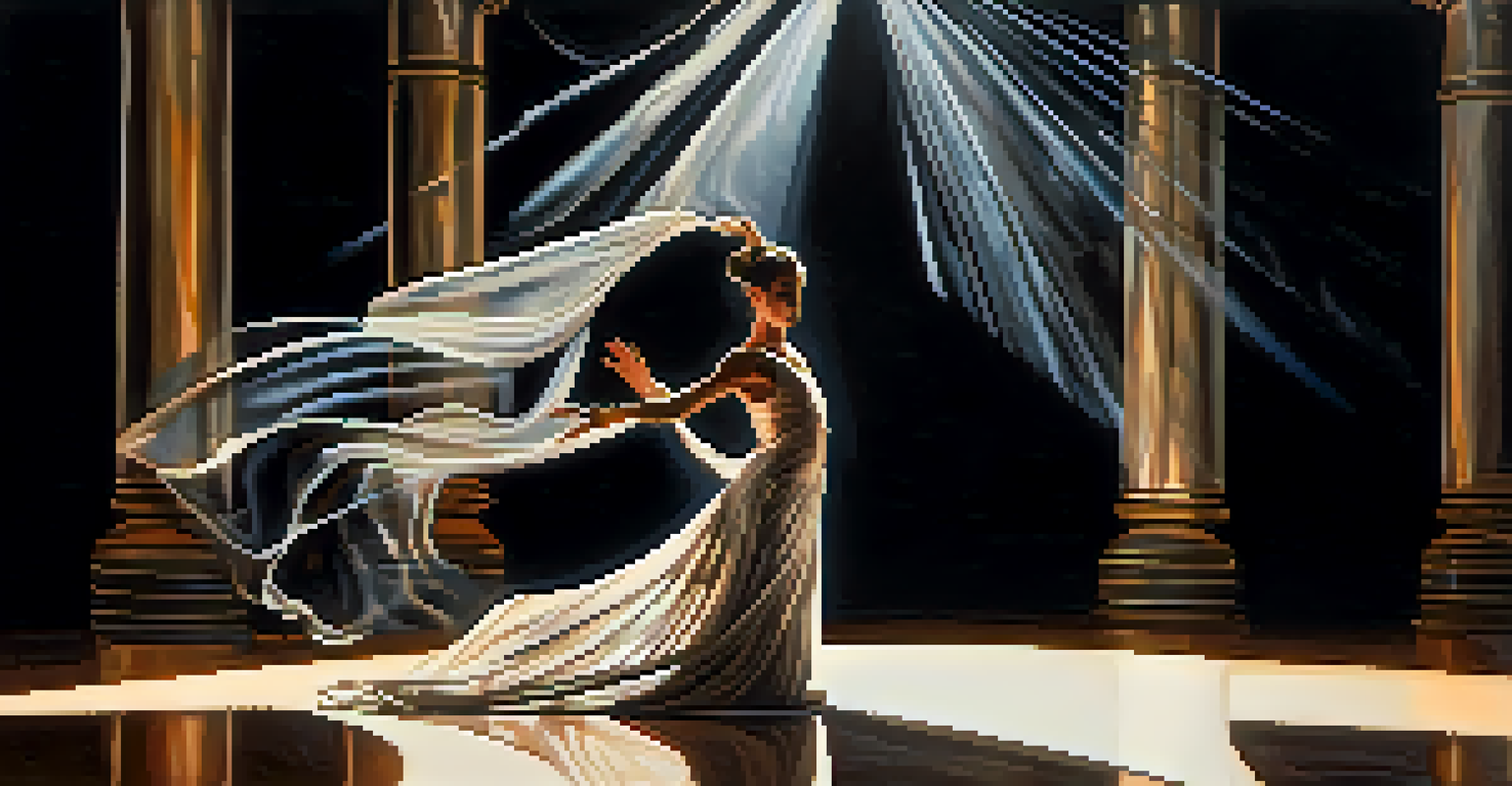Interactive Projections: Engaging Audiences in Dance Art

Understanding Interactive Projections in Dance Art
Interactive projections are digital images or videos that respond to audience movements, creating a dynamic visual experience. In the realm of dance, these projections can transform a traditional performance into an immersive art form. By integrating technology, choreographers can enhance storytelling and emotional expression through visual elements that react in real-time.
Technology has the power to transform the way we experience art, making it more interactive and engaging.
For instance, imagine a dancer moving across a stage and, with each step, colorful patterns ripple and change around them. This not only captivates the audience but also deepens their connection to the performance. The use of technology in this way fosters a unique dialogue between the dancer and the viewers, making them active participants in the art.
As interactive projections become more prevalent, they challenge the conventional boundaries of dance and visual art. Artists are now exploring how to create experiences that resonate on multiple levels, engaging not just the eyes, but also the mind and heart of the audience.
The Role of Technology in Enhancing Dance Performances
Technology plays a crucial role in modern dance performances, particularly through the use of interactive projections. These digital tools allow for a fluid exchange between the performer and their environment. As dancers move, the projections adapt and evolve, creating a captivating backdrop that complements their movements.

Consider a performance where the dancer interacts with projected rain droplets; as they leap, the droplets scatter and shift in response. This not only amplifies the visual spectacle but also conveys deeper emotions associated with the narrative. By merging physical movement with digital artistry, the dance becomes a multi-sensory experience.
Interactive Projections Transform Dance
These digital visuals create immersive experiences that deepen audience engagement and emotional connection.
Moreover, this integration of technology invites audiences to engage with the performance in new ways. It encourages them to reflect on how their own movements and feelings can influence the art unfolding before them, fostering a personal connection that transcends traditional viewing.
Creating Immersive Experiences for Audiences
Immersive experiences in dance art can be profoundly impactful, often leaving lasting memories. By using interactive projections, performers can transport audiences into different worlds, making them feel as if they are part of the journey. This sense of inclusion can enhance emotional responses and deepen the overall experience.
Art is not what you see, but what you make others see.
Imagine a scene where dancers navigate through a forest of digital trees that shift as they move. The audience feels the essence of the environment and can almost smell the fresh air. This vivid layering of visuals creates a rich tapestry of storytelling, allowing viewers to immerse themselves fully in the narrative.
Such experiences challenge the idea of passive observation and encourage active participation. When audiences feel like they are part of the performance, their emotional investment increases, making the art form even more powerful and memorable.
The Emotional Impact of Interactive Dance Art
Interactive projections not only enhance the visual experience but also evoke strong emotional responses from audiences. By syncing visuals with the mood of the dance, choreographers can amplify feelings of joy, sadness, or tension. This emotional layering invites viewers to resonate with the performance on a personal level.
For example, a dancer expressing grief might be accompanied by dark, swirling projections that mirror their movements, creating a haunting atmosphere. This synergy between movement and visual art can lead to profound moments of connection and empathy. The audience is not just witnessing a performance; they are feeling it.
Technology Enhances Dance Storytelling
By integrating technology, choreographers can craft multi-sensory narratives that resonate with viewers on various levels.
As emotions are stirred, audiences become more engaged, often reflecting on their own experiences. This unique interplay fosters a shared understanding between the dancer and the viewers, making the art not just a performance but a collective experience of human emotion.
Examples of Successful Interactive Dance Projects
Several innovative projects have successfully integrated interactive projections into dance, creating memorable experiences. One notable example is 'Transcending Boundaries,' where dancers interacted with projections that depicted shifting landscapes, reflecting their emotional journey. This project brilliantly illustrated how technology could enhance storytelling through movement.
Another example is 'Light and Motion,' a collaboration between choreographers and digital artists that allowed audience members to influence the projections during the performance. As viewers waved their arms, they altered the visuals, creating a truly interactive experience that blurred the lines between performer and audience.
These projects not only showcase the potential of interactive dance art but also inspire future artists to explore the possibilities of merging technology with traditional performance, opening up new avenues for creativity and engagement.
Challenges in Implementing Interactive Projections
While interactive projections bring exciting possibilities, they also come with challenges that artists must navigate. One major hurdle is the technical complexity involved in setting up and executing interactive elements during a performance. Coordinating live movement with digital projections requires precise timing and often involves extensive rehearsals.
Additionally, artists may face limitations in resources and technology. Not all venues are equipped with the necessary equipment to support sophisticated interactive projections, which can hinder creative expression. Finding the right balance between technology and the human element of dance is essential to maintain the integrity of the performance.
Future Innovations in Dance Art
Advancements in virtual and augmented reality promise to reshape the interactive dance landscape, offering even more engaging experiences.
Despite these challenges, many artists continue to push boundaries, experimenting with available tools and resources. The journey of integrating technology into dance is a learning process, often leading to innovative solutions and unique artistic expressions that redefine the art form.
The Future of Interactive Projections in Dance Art
The future of interactive projections in dance art looks promising, with advancements in technology paving the way for even more innovative experiences. As virtual and augmented reality continue to evolve, performers may soon explore new dimensions of interactivity that were once unimaginable. This could lead to fully immersive environments where the audience plays an active role in shaping the performance.
Moreover, as artists become more familiar with these technologies, we can expect to see even bolder storytelling techniques that incorporate a wider range of sensory experiences. From sound to tactile feedback, the possibilities are virtually limitless. This evolution will further enhance the emotional depth and engagement of dance art.

Ultimately, the integration of interactive projections is set to redefine the boundaries of dance, offering audiences new ways to connect with the art. As we look ahead, the relationship between technology and dance will undoubtedly continue to evolve, creating exciting opportunities for both artists and audiences alike.